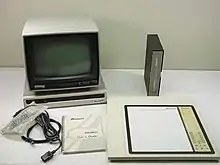| Type | Private |
|---|---|
| Industry | Electronics |
| Founded | 1980 |
| Headquarters | Waltham, Massachusetts |
| Products | PenPad / Pen Computing / Handwriting recognition |
Pencept, Inc. was one of a small number of pioneering companies in the 1980s developing and marketing technology known as pen computing.
Pencept was noted primarily for the robustness (for the time) of the handwriting and gesture recognition algorithms, and for an emphasis on developing novel user interface approaches for employing gesture recognition and handwriting recognition that would work with existing applications hardware and software.
Pencept employed a proprietary technology for on-line character recognition, based on a functional attribute model of human reading. Thus, unlike many other recognition algorithms employed for handwriting recognition, the recognition was generally user-independent and did not involve training to a user's particular writing style.
Early products included the PenPad 200[1] handwriting-only computer terminal that was a direct replacement for the VT-100 and other standard ANSI 3.62 terminals, but with a digitizing tablet and electronic pen and no keyboard. With the advent of the IBM personal computer, later products, such as the PenPad 320[2] focused particularly graphics and CAD/CAM applications for the DOS operating system, as well as for data entry and data editing applications.
The Pencept systems were featured in demonstrations at the 1983 and 1985 CHI conferences. A video[3][4] showing parts of the 1985 demonstration at the CHI 85 conference is available from the Open-Video.org on-line collection.

See also
References
- ↑ Pencept Penpad (TM) 200 Product Literature, Pencept, Inc., 1982-08-15
- ↑ Users Manual for Penpad 320, Pencept, Inc., 1984-06-15
- ↑ Software Control at the Stroke of a Pen (Video), Pencept, Inc., 1985, retrieved 2009-05-21
- ↑ Software Control at the Stroke of a Pen, Pencept, Inc., 1985, retrieved 2009-05-31